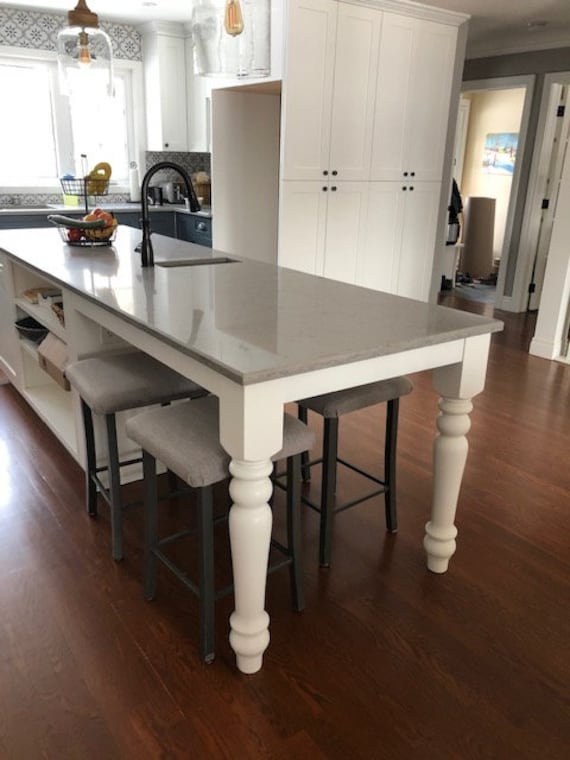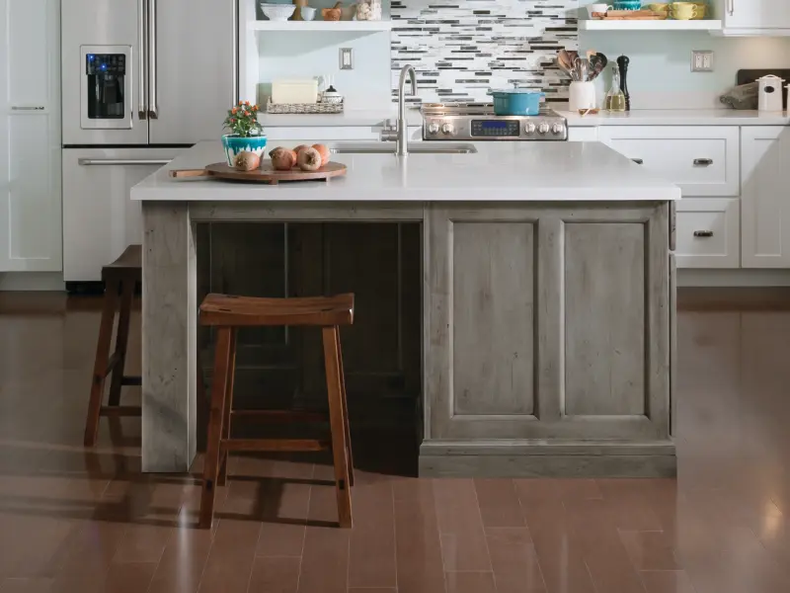Kitchen Island Legs: Add Capability and Style to Your Space
Kitchen Island Legs: Add Capability and Style to Your Space
Blog Article
A Guide to Selecting the Ideal Cooking Area Island for Your Home
Choosing the best cooking area island is a multi-faceted decision that can substantially impact both the performance and visual appeals of your home. Comprehending your kitchen area's spatial dynamics is the preliminary step, making sure that the island fits seamlessly without interrupting the circulation. Beyond room considerations, determining the primary objective of the island-- be it for dish prep work, eating, or added storage space-- is important. The choice of products and coatings likewise plays an important function in harmonizing the island with your cooking area's general style. As we discover these elements better, the nuances of each choice will certainly become clear.
Assessing Your Space
Before selecting a kitchen island, it is vital to extensively examine your area to guarantee the enhancement will be both practical and visually pleasing. Begin by gauging the available location, consisting of the width, size, and height of the kitchen. Precise dimensions are crucial to avoid acquiring an island that bewilders the area or one that is disproportionately little.
Think about the existing layout and exactly how the island will integrate with the existing web traffic flow. A well-placed island should not block pathways or hinder accessibility to crucial home appliances, such as the refrigerator, sink, and stove. Leave appropriate clearance area-- typically around 36 to 48 inches on all sides-- to allow for comfy activity and office performance.
Following, evaluate the natural light and sightlines within your kitchen. An island that obstructs a window or interrupts visual cohesion can make the area feel cramped and dark. Assume regarding how the island's placement will influence lighting and exposure, guaranteeing it enhances instead than detracts from the kitchen's setting.
Establishing the Objective
Determining the function of your kitchen area island is a crucial step in guaranteeing it satisfies your details needs and choices. Prior to diving into design or size considerations, it is important to clarify what main function the island will offer in your kitchen area. Will it be a main hub for dish preparation, a casual eating location, or perhaps an extra storage space remedy?
For those who appreciate food preparation, incorporating home appliances such as a cooktop or sink may be needed. Furthermore, enough counter area for chopping and blending, in addition to accessible storage for kitchen tools and components, can change the island into an effective workstation. Conversely, if the island is planned to facilitate social communications or offer as a dining area, seating arrangements end up being critical. In this instance, making certain adequate legroom and surface location for comfortable eating experiences is critical.

Selecting the Right Size
Selecting the ideal dimension for your kitchen area island is a balance of functionality and area optimization. A suitable cooking area island should supply sufficient work area while making certain that movement around the kitchen continues to be unblocked. Begin by measuring your kitchen area area; a minimum clearance of 36 to 42 inches around the island is necessary to enable comfy movement and availability.
The dimensions of the island need to mirror its designated usage. If the island will certainly serve primarily as a prep area, a width of 24 to 36 inches might be adequate. However, if it is to suit seats, you should consider a larger size, usually measuring at the very least 48 inches in size. Islands dedicated to sinks or devices may require added room to house these attributes adequately.

Lastly, make sure that the island's size matches the total cooking area design, avoiding any frustrating presence that could diminish the cooking area's visual and energy - kitchen island legs. Cautious preparation and specific dimensions will assist you achieve a unified and reliable cooking area environment
Picking Materials and Finishes
After determining the proper dimension for your kitchen area island, the next step includes picking suitable products and coatings. The selection of products considerably affects both the visual charm and capability of your kitchen area island. Popular materials for countertops consist of quartz, butcher, and granite block, each offering distinct benefits. Granite, known for its toughness and ageless elegance, is highly resistant to scratches and warmth. Quartz, a crafted stone, supplies a non-porous surface that withstands microorganisms and discolorations. Butcher block, made from hardwood, includes a cozy, rustic appeal and is excellent for food prep work.
Along with the counter top, think about the materials for the island base. Strong timber supplies a classic, tough appearance, while stainless-steel supplies a smooth, modern-day look and is easy to tidy. Painted finishes can introduce a dash of color, with choices varying from muted pastels to strong, vibrant tones.
When choosing surfaces, guarantee they match the total cooking area style. Matte finishes offer a modern feeling, while glossy finishes can create a refined, premium look. Take notice of the resilience of finishes, specifically in high-traffic areas, to maintain the island's look over time. Selecting the appropriate products and surfaces will certainly boost both the functionality and visual charm of your kitchen island.
Integrating Functional Attributes
Incorporating functional attributes into your kitchen area island can significantly improve its energy and benefit, changing it right into a versatile centerpiece of your kitchen. One necessary attribute to take into consideration is extra storage. Incorporating cupboards, cabinets, and open shelving can provide much-needed room for cooking equipment, tools, and tiny appliances, helping to keep a clutter-free atmosphere.
One more valuable enhancement is an integrated sink or cooktop, which can simplify meal preparation and clean-up processes. A sink can help with jobs such as cleaning vegetables and cleansing meals, while a cooktop can enable food preparation straight on the island, cultivating an extra interactive and social food preparation experience.
Think about incorporating seating alternatives, especially if your kitchen area functions as a casual dining area. Bar feceses or built-in benches can transform the island right into a multifunctional area for dishes, research, or informal celebrations.
Last but not least, incorporating a knockout post electrical outlets right into your cooking area island can enhance its usefulness. Outlets give practical gain access to for little cooking area home appliances, billing stations for electronic devices, and extra lighting alternatives.
Verdict

Before choosing a kitchen area island, it is crucial to thoroughly assess your space to ensure the addition will certainly be both functional and visually pleasing.Choosing the best size for your kitchen island is a balance of functionality and space optimization. kitchen island legs. An optimal kitchen area island ought to offer adequate work area while making certain that activity around the kitchen area stays unobstructed.Incorporating functional attributes into your kitchen island can significantly improve its utility and ease, transforming it into a flexible centerpiece of your kitchen.In verdict, choosing the suitable kitchen area island demands an extensive assessment of the readily available room, clearness concerning its key function, and cautious factor to consider of the suitable size and products
Report this page